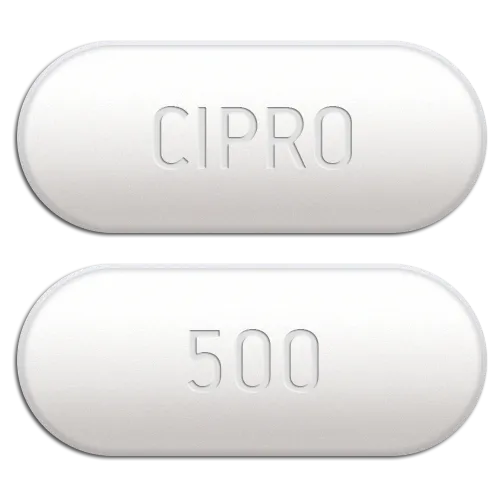Overview
Cipro, known generically as ciprofloxacin, is a broad-spectrum fluoroquinolone antibiotic used to treat various bacterial infections. It works by inhibiting bacterial DNA gyrase and topoisomerase IV, enzymes critical for bacterial replication and repair, effectively halting bacterial growth. Available in multiple forms, including tablets, extended-release tablets, oral suspensions, and intravenous solutions, Cipro is a versatile option for addressing infections throughout the body.
Primary Uses
Cipro is prescribed to treat a range of bacterial infections, including:
- Urinary tract infections (UTIs)
- Respiratory tract infections (e.g., pneumonia, bronchitis)
- Skin and soft tissue infections
- Gastrointestinal infections (e.g., infectious diarrhea)
- Bone and joint infections
- Intra-abdominal infections
- Certain sexually transmitted infections
- Anthrax (post-exposure prophylaxis and treatment)
Key Benefits
- Broad-Spectrum Efficacy: Targets both gram-positive and gram-negative bacteria.
- Rapid Action: Quickly reduces bacterial growth, leading to fast symptom relief.
- Versatile Applications: Effective for a wide variety of infections, offering flexibility in treatment.
Efficacy
Clinical studies confirm Cipro’s effectiveness in treating bacterial infections, with patients often experiencing rapid symptom improvement and successful infection eradication. Its broad-spectrum activity makes it ideal for empirical therapy when the causative bacteria are unknown.
Safety and Tolerability
Cipro is generally well-tolerated, with common side effects including nausea, diarrhea, dizziness, headache, and abdominal pain, which are typically mild and temporary. Serious side effects, such as tendonitis, tendon rupture, peripheral neuropathy, or central nervous system effects, are rare but require immediate medical attention. Regular monitoring by a healthcare provider is advised.
Dosage and Administration
Dosage: Typically 250–750 mg every 12 hours, depending on the infection’s type and severity. Doses are adjusted based on patient age, kidney function, and response to treatment.
Timing: Administered twice daily, approximately 12 hours apart, with or without food. Take with a full glass of water.
Additional Notes: Avoid calcium-rich foods, dairy, or antacids within two hours of dosing, as they may reduce absorption. If a dose is missed, take it as soon as remembered unless it’s nearly time for the next dose; do not double up.
Mechanism of Action
Cipro inhibits bacterial DNA gyrase and topoisomerase IV, disrupting DNA replication, transcription, and repair, leading to bacterial cell death. This results in rapid resolution of infection symptoms and effective treatment of the underlying cause.
Composition
Active Ingredient: Ciprofloxacin, responsible for the antibiotic’s antibacterial effects.
Inactive Ingredients: May include microcrystalline cellulose, corn starch, magnesium stearate, and colloidal silicon dioxide for tablet stability and formulation.
Side Effects
Common: Nausea, diarrhea, dizziness, headache, abdominal pain.
Less Common: Rash, photosensitivity, gastrointestinal disturbances.
Serious: Tendonitis, tendon rupture, peripheral neuropathy, or central nervous system effects require urgent medical attention.
Prevention of Side Effects
Follow prescribed dosages, stay hydrated, and avoid sun exposure to minimize risks. Use sunscreen and protective clothing to prevent photosensitivity. Report adverse effects to a healthcare provider promptly for potential dose adjustments.
Contraindications
Cipro is contraindicated in patients with:
- Known allergies to ciprofloxacin or other quinolones.
- Myasthenia gravis, due to the risk of exacerbating muscle weakness.
Warnings and Precautions
Avoid driving or operating machinery until the effects of Cipro are known. Monitor for signs of tendonitis or tendon rupture, and report symptoms immediately. Regular follow-up with a healthcare provider is essential to manage risks.
Drug Interactions
Cipro may interact with:
- Antacids or supplements containing calcium, magnesium, aluminum, or iron, reducing absorption.
- Theophylline, increasing the risk of serious side effects.
- Warfarin, heightening bleeding risk.
Inform your healthcare provider of all medications to avoid interactions.
Overdose
Symptoms include dizziness, confusion, tremors, hallucinations, or gastrointestinal issues. Seek emergency medical help immediately and avoid inducing vomiting unless instructed.
Pharmacokinetics
Absorption: Rapid, with peak plasma levels in 1–2 hours.
Distribution: Widely distributed to tissues and fluids, including urine and lungs.
Metabolism: Minimal liver metabolism, with most excreted unchanged.
Elimination: Primarily via urine, with a half-life of 4–5 hours.
Dosage Forms
Cipro is available as tablets (250–750 mg), extended-release tablets, oral suspensions, and intravenous solutions. Tablets and suspensions are convenient for routine use, while extended-release and IV forms suit specific needs, such as once-daily dosing or severe infections.
Pregnancy and Breastfeeding
Use during pregnancy only if benefits outweigh risks, as safety is not fully established. Cipro is excreted in breast milk, so breastfeeding mothers should consult their healthcare provider and monitor infants for adverse effects if used.
Storage
Store at 20°C–25°C (68°F–77°F) in a dry, light-protected container, out of reach of children. Check expiration dates and dispose of unused medication properly.
Clinical Evidence
Clinical trials validate Cipro’s efficacy in treating diverse bacterial infections, demonstrating rapid symptom relief and bacterial eradication. Its broad-spectrum activity ensures effectiveness against various pathogens.
Conclusion
Cipro is a highly effective antibiotic for managing bacterial infections, offering broad-spectrum activity, rapid action, and flexible dosing. Patients should adhere to medical guidance, monitor for side effects, and maintain regular check-ups for optimal outcomes.




